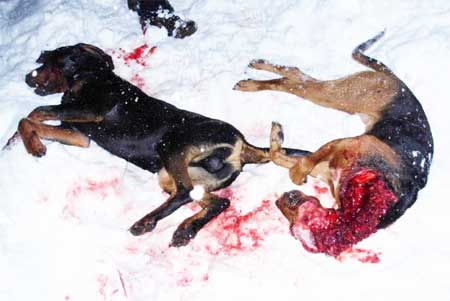8 Pet Dogs Killed by Wolves in Wisconsin in 2010 – Who is Endangered Now?
With animal rights groups wanting to unleash wolves across the US could your family pet be next on the endangered species list…AmmoLand.com


Wisconsin –-(Ammoland.com)- Each year, with the beginning of the Wisconsin bear hound training and hunting season, bear hunters are reminded to exercise caution if they plan to train or hunt bear with hounds.
As of August 3rd, eight hounds have been killed by wolves since the opening of bear hound training season. Hunters should use the caution area maps below to help reduce conflicts during this year’s bear dog training season. Table 1 contains a summary of the 2010 dog depredations by wolves.
**Anyone suspecting a wolf attack in northern Wisconsin should call USDA-WS immediately at 1-800-228-1368.
Caution Areas and Wolf Behavior
When wolves attack dogs in hunting or training situations, the Wisconsin DNR will create “wolf caution areas” to warn hunters that a specific pack has attacked a dog or group of dogs. (What are Wolf Caution Areas?) Bear hunters are urged to exercise greater caution if they plan to train hounds or hunt bear with hounds near any caution area, especially if near an actual kill site. Table 1 contains a summary of the 2010 dog depredations by wolves with additional information and caution area maps shown below.
As with other wild canids, wolves are very territorial and will guard their territories from other wolves, coyotes, and domestic dogs. Wolves are probably most aggressive toward strange wolves and dogs at den and rendezvous sites when their pups are small, during the breeding season in January and February, and when they are protecting a fresh kill. Wolf packs have pups in spring and then later will use rendezvous sites from mid June to late September, after the pups are big enough to leave their den. Adult wolves are very defensive of pups at rendezvous sites and will attack other predators, including dogs, that get too close to the rendezvous site or the pups.
A pack will use from 2 to 3 to as many as 6 or more rendezvous sites during the summer. The exact locations vary from year to year and throughout the summer. The sites are usually forest openings or edge areas, with lots of wolf tracks, droppings, and matted vegetation. Move 2 or 3 miles from any rendezvous site, if possible, before releasing dogs. In addition, avoid releasing dogs at baits recently visited by wolves. When looking for bear sign at a bait, make sure to also look for wolf tracks. Be familiar with your own dog’s tracks, so that you can distinguish it from any wolf tracks. If a specific bait site is receiving a lot of wolf use, discontinue using it until wolves have left, and concentrate on an alternative bait site. Some hunters have had success with bells on dog collars to reduce wolf attacks, but some dogs with bells have been attacked by wolves. For more options on reducing the likelihood of wolf attacks on hounds see:
- A Guide to Reducing Conflict between Wolves and Hunting Dogs
- Guidance for Bear Hunters and Pet Owners
Pet Dogs
Although wolf attacks on pet dogs in residential areas are rare, they do occur and have increased in recent years. These types of attacks represent a special kind of wolf depredation to domestic animals. For additional guidance and information about protecting pet dogs and bear hounds from wolves, see “Guidance for Bear Hunters and Pet Owners”.
